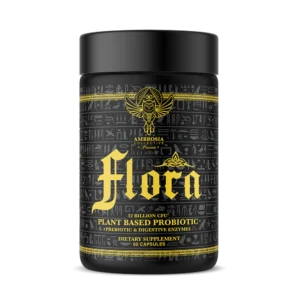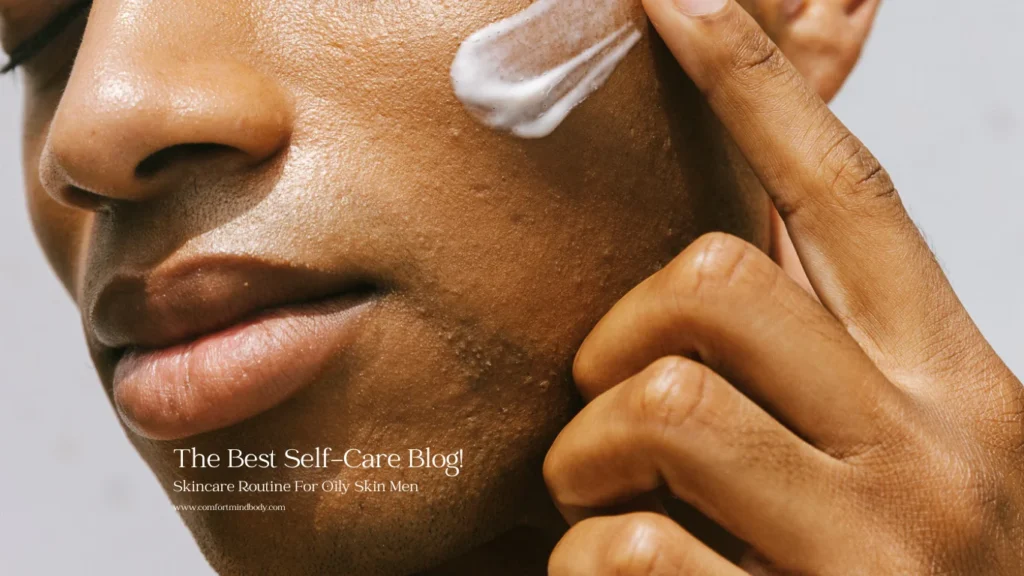Table of Contents
ToggleIntroduction:
Navigating the world of skincare can be a daunting task, especially for men with oily skin. The struggle to manage excess oil and maintain a clear complexion is real. But fear not.
This comprehensive guide is designed to help you understand and manage oily skin effectively. We will delve into the science of oily skin, debunking common myths along the way.
You’ll learn about the essential steps in a skincare routine tailored for men with oily skin. From cleansing and toning to moisturizing and applying sunscreen, each step will be explained in detail.
Plus, we’ll also explore advanced skincare techniques, such as the use of serums, spot treatments, and masks. Professional treatments will be discussed, helping you decide when to consider them.
But skincare isn’t just about the products you apply on your skin. It’s also about the lifestyle choices you make.
- First we will discuss the role of diet, exercise, stress management, and sleep in maintaining healthy skin. Choosing the right products for your skin type is crucial.
- Second, we’ll guide you through the process, highlighting the ingredients to look for and those to avoid.
- Third, we’ll also answer common questions and address concerns related to oily skin, acne, large pores, and seasonal skincare adjustments.
Finally, we’ll emphasize the importance of consistency and patience in achieving your skincare goals.
This guide is your roadmap to a healthier, clearer complexion. Let’s embark on this journey to better skin health together.
Understanding Oily Skin in Men
skincare routine for oily skin men
Before we delve into the skincare routine, it’s crucial to understand what oily skin is. Oily skin is characterized by an overproduction of sebum, the skin’s natural oil.
This overproduction can lead to a shiny appearance, enlarged pores, and a higher propensity for acne and blackheads. But why does this happen?
Let’s explore the science behind oily skin.
The Science of Oily Skin
Sebum is produced by sebaceous glands, which are found in the skin’s dermis layer. This oil serves a purpose. It helps to keep the skin hydrated, protects it from environmental damage, and maintains its elasticity.
However, when these glands produce too much sebum, it can lead to oily skin. The overproduction of sebum can be influenced by various factors, including genetics, hormones, and environmental conditions.
Understanding these factors can help in managing oily skin effectively. Let’s delve into these contributing factors.
Factors Contributing to Oily Skin
Genetics play a significant role in determining your skin type. If your parents have oily skin, there’s a high chance you will too. Hormonal fluctuations can also influence sebum production.
For instance, higher levels of androgens (male hormones) can trigger increased sebum production. This is why oily skin and acne are common during puberty, a period of significant hormonal changes.
Environmental factors, such as humidity and heat, can also stimulate oil production. On the other hand, cold and dry conditions can cause the skin to overcompensate for dryness by producing more oil.
- Genetics
- Hormonal changes
- Environmental conditions
Understanding these factors can help you tailor your skincare routine and lifestyle choices to better manage oily skin. However, it’s also important to dispel common myths about oily skin.
Let’s debunk some of these misconceptions.
Common Myths About Oily Skin
skincare routine for oily skin men
One common myth is that oily skin doesn’t need moisturizing. In reality, skipping moisturizer can cause your skin to produce more oil to compensate for the lack of hydration.
Another myth is that oily skin is dirty, leading some to over-cleanse their skin. This can strip the skin of its natural oils, causing it to produce even more oil.
A third myth is that oily skin doesn’t age. While oily skin may show signs of aging later than dry skin, it’s not immune to wrinkles and other signs of aging.
- Oily skin doesn’t need moisturizing
- Oily skin is dirty
- Oily skin doesn’t age
Understanding the truth behind these myths can guide you in establishing an effective skincare routine for oily skin. In the next section, we’ll discuss the essential steps in a skincare routine for men with oily skin.
Essential Steps in a Skincare Routine for Oily Skin Men
A skincare routine for oily skin men involves several key steps. Each step serves a specific purpose in managing oil production, preventing acne, and promoting a clear complexion.
Let’s explore these steps in detail.
Step 1: Cleansing
Cleansing is the first and most crucial step in any skincare routine. It helps remove excess oil, dirt, and impurities from the skin’s surface. For oily skin, it’s best to use a gentle, oil-free cleanser.
Such a cleanser can effectively remove excess oil without stripping the skin of its natural moisture. Over-cleansing or using harsh cleansers can cause the skin to produce more oil.
So, it’s recommended to cleanse twice a day: once in the morning and once at night. Remember to cleanse your face after sweating heavily as well.
This can prevent sweat and oil from clogging your pores.
Step 2: Toning
After cleansing, the next step is toning. Toners help to balance the skin’s pH levels. They also remove any residual dirt or oil left after cleansing.
For oily skin, look for a toner with ingredients like witch hazel or salicylic acid. These ingredients can help control oil production and prevent acne.
Apply the toner using a cotton pad, gently wiping it over your face. Avoid toners with alcohol as they can dry out the skin and trigger more oil production.
Step 3: Moisturizing
Despite the common myth, oily skin needs moisturizing too. Moisturizing helps to hydrate the skin and lock in its natural moisture. For oily skin, opt for a lightweight, oil-free moisturizer.
Ingredients like hyaluronic acid and glycerin can provide hydration without making the skin feel greasy. Apply the moisturizer while your skin is still damp from the toner.
This can help the moisturizer absorb better and keep your skin hydrated longer.
Step 4: Applying Sunscreen
Sunscreen is a must in any skincare routine, regardless of skin type. It protects the skin from harmful UV rays, which can cause premature aging and skin cancer.
For oily skin, choose a water-based, non-comedogenic sunscreen. Such a sunscreen can protect your skin without clogging your pores or making your skin feel greasy.
Apply sunscreen every day, even on cloudy days, as UV rays can penetrate through clouds. Reapply every two hours when you’re outdoors for extended periods.
Step 5: Exfoliating
The last step in the basic skincare routine is exfoliating. Exfoliation helps remove dead skin cells that can clog pores and cause acne. For oily skin, it’s best to use a chemical exfoliant like salicylic acid or glycolic acid.
These exfoliants can penetrate deep into the pores and remove excess oil and dead skin cells. Exfoliate 1-2 times a week, depending on your skin’s tolerance.
Over-exfoliation can irritate the skin and trigger more oil production. In the next section, we’ll discuss advanced skincare techniques for oily skin.
Minimalistic Step-by-Step Guide:
skincare routine for oily skin men
Advanced Skincare Techniques for Oily Skin
skincare routine for oily skin men
Beyond the basic steps, there are advanced techniques that can further enhance your skincare routine. These techniques can provide targeted treatment for specific skin concerns.
They can also boost the effectiveness of your basic skincare routine. Let’s delve into these advanced techniques.
Using Serums and Spot Treatments
Serums are lightweight, fast-absorbing liquids that deliver a high concentration of active ingredients to the skin. They can target specific skin concerns like acne, hyperpigmentation, and aging.
For oily skin, look for a serum with ingredients like niacinamide, salicylic acid, or hyaluronic acid. Niacinamide can regulate oil production, salicylic acid can unclog pores, and hyaluronic acid can provide lightweight hydration.
Apply the serum after toning and before moisturizing. Spot treatments, on the other hand, are used to treat individual pimples or acne.
They contain a high concentration of acne-fighting ingredients like benzoyl peroxide or salicylic acid. Apply the spot treatment directly to the pimple after applying your serum and moisturizer.
Remember to use spot treatments sparingly as they can dry out the skin if overused.
The Role of Masks in Oil Control
Masks can provide a deep cleansing and oil-controlling treatment for your skin. They can draw out impurities, absorb excess oil, and unclog pores. For oily skin, clay masks are particularly beneficial.
Clay can absorb excess oil and reduce the appearance of pores. Apply a clay mask once or twice a week after cleansing and before the rest of your skincare routine.
Leave the mask on for the recommended time, usually 10-15 minutes, then rinse off with warm water. Avoid leaving the mask on for too long as it can dry out the skin.
Professional Treatments and When to Consider Them
skincare routine for oily skin men
Professional treatments like facials, chemical peels, and laser treatments can provide more intensive care for your skin. They can address stubborn skin issues that are not responsive to at-home treatments.
Facials can provide a deep cleansing and exfoliating treatment for your skin. They can also include extractions to remove blackheads and whiteheads.
Chemical peels use a high concentration of acids to exfoliate the skin deeply. They can improve skin texture, reduce acne, and fade hyperpigmentation.
Laser treatments, on the other hand, can target specific skin concerns like acne scars, large pores, and uneven skin tone. Consider professional treatments if your skin issues persist despite following a consistent skincare routine.
Remember to consult with a dermatologist or a skincare professional before undergoing any professional treatments. They can assess your skin condition and recommend the most suitable treatment for you.
In the next section, we’ll discuss lifestyle adjustments that can improve your skin health.
Lifestyle Adjustments for Better Skin Health
skincare routine for oily skin men
Your lifestyle plays a significant role in the health of your skin. Diet, exercise, stress management, and sleep can all impact your skin’s condition. Let’s explore how you can make lifestyle adjustments to improve your skin health.
Diet and Nutrition for Oily Skin
What you eat can affect your skin’s health and appearance. Certain foods can trigger oil production, while others can help control it. For oily skin, it’s beneficial to consume a diet rich in fruits, vegetables, lean proteins, and healthy fats.
These foods provide essential nutrients that can improve your skin’s health. Avoid foods high in sugar and unhealthy fats as they can trigger inflammation and oil production. Here are some dietary tips for oily skin:
- Consume foods rich in omega-3 fatty acids like fish, walnuts, and flaxseeds.
- Eat foods high in antioxidants like berries, spinach, and dark chocolate.
- Drink plenty of water to keep your skin hydrated.
- Limit your intake of dairy products as they can stimulate oil production.
- Avoid processed foods and sugary drinks as they can cause inflammation.
Remember, everyone’s body is different. What works for one person may not work for another. It’s important to listen to your body and adjust your diet accordingly.

Flora probiotic + prebiotic & digestive enzyme
This is the only vegan-friendly Probiotic with 30 Billion CFUs, a vegan-based Prebiotic blend, and a clinically proven digestive enzyme designed to help you feel better immediately
Exercise and Stress Management
Regular exercise can improve your skin’s health by increasing blood circulation. This can help nourish your skin cells and remove waste products. Exercise can also help manage stress, which can trigger oil production.
Here are some tips for exercise and stress management:
- Aim for at least 30 minutes of moderate exercise most days of the week.
- Try stress-reducing activities like yoga, meditation, or deep breathing exercises.
- Take breaks throughout the day to relax and unwind.
- Get outside and enjoy nature.
- Connect with friends and family to boost your mood.
Remember, it’s important to cleanse your skin before and after exercise to remove sweat and oil.
Sleep and Skin Health
Sleep is essential for your skin’s health. During sleep, your skin repairs and regenerates itself. Lack of sleep can lead to increased stress and inflammation, which can trigger oil production. Aim for 7-9 hours of quality sleep each night.
Create a relaxing bedtime routine to help you wind down. This could include reading a book, listening to calming music, or practicing deep breathing exercises. Avoid screens before bed as the blue light can disrupt your sleep.
Ensure your bedroom is dark, quiet, and at a comfortable temperature. Remember, your pillowcase can accumulate oil and bacteria. Change it regularly to avoid breakouts.
In the next section, we’ll discuss how to choose the right products for oily skin.
Choosing the Right Products for Oily Skin
skincare routine for oily skin men
Choosing the right skincare products is crucial for managing oily skin. The products you use can either help control oil production or exacerbate it.
In this section, we’ll discuss the ingredients to look for and avoid in skincare products. We’ll also provide some product recommendations based on reviews and expert advice.
Ingredients to Look For
Certain ingredients can help control oil production and promote a clear complexion.
Here are some ingredients to look for in skincare products for oily skin:
- Salicylic Acid: This beta-hydroxy acid (BHA) can penetrate into the pores and dissolve excess sebum.
- Niacinamide: Also known as vitamin B3, niacinamide can help regulate oil production and reduce inflammation.
- Hyaluronic Acid: This ingredient can provide lightweight hydration without making the skin feel greasy.
- Bentonite Clay: This clay can absorb excess oil and draw out impurities from the skin.
- Witch Hazel: This natural astringent can help tighten the pores and control oil production.
Remember, it’s important to patch test new products to ensure they don’t cause irritation.
Ingredients to Avoid
Just as there are ingredients that can benefit oily skin, there are also ingredients that can worsen it. Here are some ingredients to avoid in skincare products for oily skin:
- Alcohol: This can strip the skin of its natural oils, causing it to produce more oil to compensate.
- Coconut Oil: While it’s a popular natural moisturizer, coconut oil can clog pores and lead to breakouts.
- Synthetic Fragrances: These can irritate the skin and trigger oil production.
- Isopropyl Myristate: This ingredient can clog pores and cause acne.
- Lanolin: While it’s a natural moisturizer, lanolin is heavy and can clog pores.
Remember, everyone’s skin is different. What irritates one person’s skin may not irritate another’s. Always listen to your skin and adjust your skincare routine accordingly.
Product Recommendations and Reviews
skincare routine for oily skin men
Now that you know what ingredients to look for and avoid, let’s discuss some product recommendations. These products have been highly rated by users with oily skin and contain beneficial ingredients.
For cleansers, consider the CeraVe Foaming Facial Cleanser or the La Roche-Posay Effaclar Purifying Foaming Gel. Both are formulated with ingredients that can help control oil without stripping the skin.
For toners, the Paula’s Choice Skin Balancing Pore-Reducing Toner and the Thayers Witch Hazel Toner are popular choices. They can help balance the skin’s pH and control oil production.
For moisturizers, the Neutrogena Hydro Boost Water Gel and the Cetaphil PRO Oil Absorbing Moisturizer are worth considering. They provide lightweight hydration and contain ingredients like hyaluronic acid and niacinamide.
For sunscreens, the EltaMD UV Clear Facial Sunscreen and the La Roche-Posay Anthelios Clear Skin Sunscreen are highly rated. They’re lightweight, oil-free, and won’t clog pores.
Remember, what works for one person may not work for another. It’s important to try different products and see what works best for your skin.
In the next section, we’ll address some common questions and concerns about oily skin.
Common Questions and Concerns
skincare routine for oily skin men
In this section, we’ll address some common questions and concerns about oily skin. We’ll discuss how to deal with acne and breakouts, manage large pores and blackheads, and adjust your skincare routine for different seasons.
Dealing with Acne and Breakouts
Acne and breakouts are common concerns for those with oily skin. Here are some tips to help manage acne and breakouts:
- Keep your skin clean: Regularly cleanse your skin to remove excess oil and prevent clogged pores.
- Use non-comedogenic products: These products are formulated to not clog pores.
- Don’t pop pimples: This can lead to scarring and further breakouts.
- Use spot treatments: Products with salicylic acid or benzoyl peroxide can help treat individual pimples.
- Consult a dermatologist: If your acne is severe or persistent, it may be best to seek professional help.
Remember, everyone’s skin is different. What works for one person may not work for another. It’s important to try different methods and see what works best for your skin.
Managing Large Pores and Blackheads
Large pores and blackheads are another common concern for those with oily skin. Here are some tips to help manage large pores and blackheads:
- Regularly exfoliate: This can help remove dead skin cells and reduce the appearance of pores.
- Use products with niacinamide: This ingredient can help reduce the production of sebum, which can make pores appear smaller.
- Avoid pore-clogging ingredients: Ingredients like coconut oil and isopropyl myristate can clog pores and lead to blackheads.
- Use clay masks: These can help absorb excess oil and reduce the appearance of pores.
- Consider professional treatments: Treatments like chemical peels and microdermabrasion can help reduce the appearance of large pores and blackheads.
Remember, it’s impossible to completely eliminate pores. They’re a natural part of your skin. However, you can take steps to reduce their appearance and prevent them from becoming clogged.
Skincare Routine Adjustments for Different Seasons
skincare routine for oily skin men
Your skincare routine may need to be adjusted based on the season. Here are some tips for adjusting your skincare routine for different seasons:
- Summer: You may need to cleanse more often to remove excess sweat and oil. Consider using a lighter moisturizer and a sunscreen with a higher SPF.
- Fall: As the weather cools, you may need to switch to a more hydrating cleanser and moisturizer. Continue to use sunscreen.
- Winter: This season can be drying, so you may need to use a more hydrating moisturizer. Consider using a humidifier to add moisture to the air.
- Spring: As the weather warms, you may need to switch back to a lighter moisturizer. Continue to use sunscreen and consider adding an antioxidant serum to your routine.
Remember, these are just guidelines. Your skincare routine should be tailored to your skin’s needs, which can change based on a variety of factors. In the next section, we’ll wrap up with some final thoughts and encouragement.
Final Thoughts
skincare routine for oily skin men
As we conclude this comprehensive guide, it’s important to remember that skincare is a journey. It’s not about achieving perfection, but about improving and maintaining the health of your skin.
Your skin is unique, and what works for others may not work for you. It’s crucial to listen to your skin and adjust your routine as needed.
Remember, it’s okay to seek professional help if you’re struggling with your skin. Dermatologists and estheticians are trained to help you understand and care for your skin.
The Importance of Consistency
Consistency is key in skincare. Establishing a routine and sticking to it is one of the best things you can do for your skin. It may take time to see results, but don’t be discouraged.
Your skin renews itself every 28 days, so it can take a few cycles to see significant changes. Remember, skincare is a form of self-care.
Taking the time to care for your skin can be a relaxing and rewarding part of your day.
Patience and Tracking Progress
Patience is also crucial in skincare. It’s tempting to try every new product and technique, but this can overwhelm your skin. Instead, introduce new products slowly and give them time to work.
Consider keeping a skin diary to track your progress. This can help you identify what’s working and what’s not. Remember, your skin is a reflection of your overall health.
Taking care of your skin is an important part of taking care of your overall well-being. We hope this guide has been helpful and encourages you to establish a skincare routine that works for you.
Affiliate Disclosure:
The links contained in this product review may result in a small commission. This goes towards supporting our research and editorial team and please know we only recommend high-quality products.
Note: This article is for informational purposes only and is not intended to diagnose, treat, or cure any disease. Always consult a healthcare professional before taking any supplement or making any changes to your diet or lifestyle.
Resourses:
skincare routine for oily skin men
Current Version: May 5, 2025
Written By: Anna Vovk
- Addressing Male Facial Skin Concerns: Clinical Efficacy of a Topical Skincare Treatment jddonline.com
- Oily Skin: A Review of Treatment Options PMC
- Top Trends Shaping the Future of Men’s Skin Care Euromonitor
- Novel Tripeptide to Control Skin Oiliness for All Ages Cosmetics Business
- SkinCeuticals’s New Vitamin C Serum for Oily Skin Types Allure
- The Super Skincare Ingredient That Calms Redness, Balances Oily Skin & Reduces Wrinkles The Sun
- The Ultimate Skin Care Routine for Oily Skin Healthline
- The Ultimate Guide to Skin Care for Men Strive Skin
- Men’s Skincare Routine for Oily Skin: 5 Essential Steps + Products Yo Pretty Boy
- Skin Care Tips for Men – American Academy of Dermatology AAD.org












